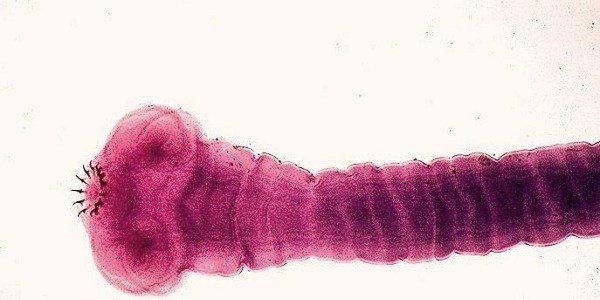Pork tapeworm

Swine tapeworm or Taenia solium is the most harmful parasite to humans.
Infestation occurs from human feces containing cestode eggs or from poorly cooked pork containing cysts with larvae.
If ingested, they reach sexual maturity in the small intestine. This type of parasitosis is called taeniosis and is often asymptomatic.
If eggs are swallowed, then the disease cysticercosis develops. Both diseases are common in Africa, Asia, South America and southern Europe.
Taeniosis is rare in Muslim countries because people there do not consume pork.
Taeniasis
Taenia solium, as its Latin name suggests, uses pigs as intermediate hosts in its larval stage of development.
Pigs can get cysticercosis. If a person consumes poorly cooked pork, the latent larvae enter the intestines.
The larva matures into an adult tapeworm by absorbing nutrients from passing food.
The body of Taenia solium is flat and consists mainly of segments, proglottids. The flatworm attaches to the intestinal wall with its head, the scolex, which consists of four suction cups and two rings of hooks.
The cestode also has a neck from which new members are formed, from which it increases in size as it moves towards the rectum.
The gills absorb nutrients from passing food and produce eggs that remain inside them until they are passed in the feces.
Each proglottid is less than 1 cm long and 2 cm wide, containing up to 50,000 eggs. Taenia solium reaches a length of up to 7 meters.
Having reached its maximum size, the cestode consists of 1000 members and releases 6 egg-filled members per day. Once in nature, they can be accidentally swallowed by a person or a pig.
What are the symptoms?
Teniosis is usually characterized by mild non-specific symptoms, it may present with abdominal pain, nausea, diarrhea or constipation, which usually develop 6-8 weeks after ingestion of the eggs or the cysts.
Clinical manifestations continue until the cestode dies after drug therapy is administered, otherwise it can remain in the human body for many years.
According to the parasitologists in Bulgaria, there is no pig tapeworm, and the frequent cases in recent years are due to untreated cases in which the parasitism occurred 30-40 years ago, but no attention was paid to it and the parasitosis only after such a long period it gave more serious complications.
In case of cysticercosis, the infected person may not experience any symptoms for many years or even feel them, they are so mild that he does not pay attention to them.
In some of the endemic areas, especially in Asia, infected people may have visible or palpable subcutaneous nodules.
At the start of treatment, a process of inflammatory reaction around the site of the cysts may begin. This usually leads to the appearance of clinical symptoms, depending on the location of the cysts.
Treatment of pig tapeworm
Taeniasis is easily treated with praziquatel – a single dose of 5-10 mg/kg. body weight or niclosamide – for adults and children over 6 years of age, a single dose of 2 years after a light breakfast, followed by a laxative within 2 hours of intake; for children from 2 to 6 years 1 year, and for those under 2 years under 500 mg.
Treatment of cysticercosis in humans is difficult and results are variable. It may consist of long-term drug therapy with praziquatel and/or albendazole and supportive treatment with corticosteroids or anticonvulsants and possible surgery.
/p>



